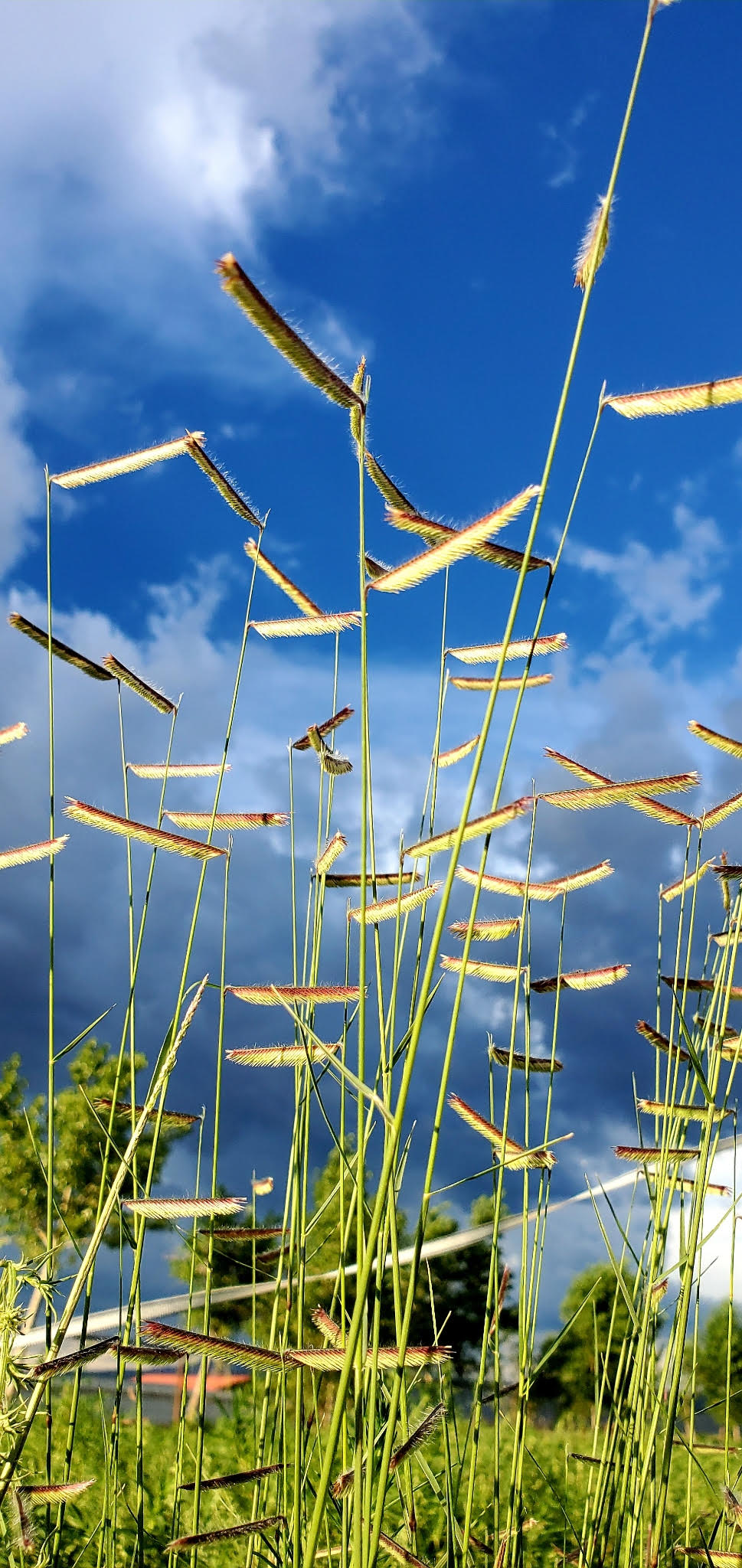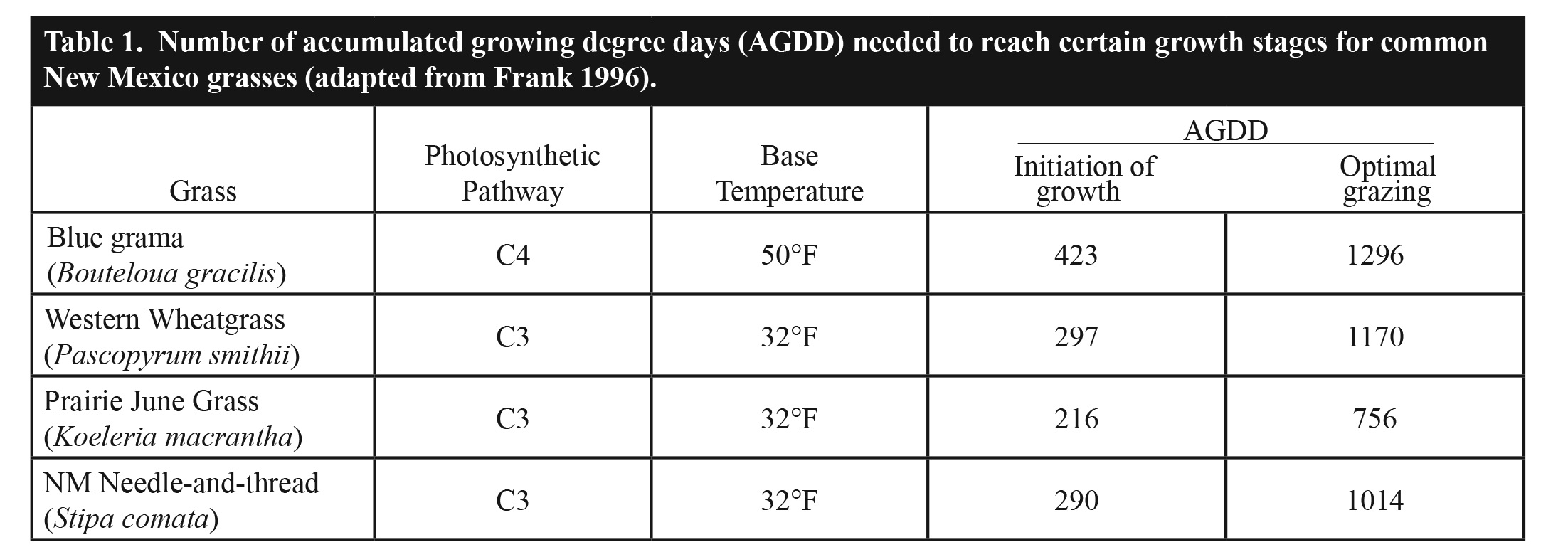Guide B-826
Taylor Sanchez, Rossana Sallenave, Amy Ganguli and Katie Meiklejohn
College of Agricultural, Consumer and Environmental Sciences, New Mexico State University
Authors: Respectively: Natural Resource Director, Sierra Soil and Water Conservation District, NM; Extension Aquatic Ecology Specialist, Department of Extension Animal Sciences and Natural Resources, New Mexico State University; former Associate Professor, Department of Animal and Range Sciences, New Mexico State University and currently National Program Leader, National Institute of Food and Agriculture, U.S. Department of Agriculture; Working Landscapes Program Manager, Ranch Advisory Partners, MT. (Print Friendly PDF)
Introduction
 Rangeland management activities such as rotational grazing, herbicide application, and seeding require specific timing to be successful. However, due to weather fluctuations and changes in climate regimes, the timing of plant development can differ significantly from one year to the next. By utilizing different monitoring methods, as opposed to calendar dates, land managers can make more informed decisions and better time key management practices, which will benefit both forage resources and livestock. The objective of this document is to explain how accumulated growing degree days (GDD) can be used to track the development of plants on rangelands, which can facilitate the timing and adoption of adaptive management plans. Growing degree days are defined as the number of heat or thermal units required to reach different stages of growth and development. For example, grasses need to accumulate a specific number of thermal units to develop leaves and grow beyond a point where grazing can cause detrimental effects. Pastures can receive that number of thermal units at different times each year, depending on weather conditions. Recognizing these patterns each year can aid in optimal timing for several management practices.
Rangeland management activities such as rotational grazing, herbicide application, and seeding require specific timing to be successful. However, due to weather fluctuations and changes in climate regimes, the timing of plant development can differ significantly from one year to the next. By utilizing different monitoring methods, as opposed to calendar dates, land managers can make more informed decisions and better time key management practices, which will benefit both forage resources and livestock. The objective of this document is to explain how accumulated growing degree days (GDD) can be used to track the development of plants on rangelands, which can facilitate the timing and adoption of adaptive management plans. Growing degree days are defined as the number of heat or thermal units required to reach different stages of growth and development. For example, grasses need to accumulate a specific number of thermal units to develop leaves and grow beyond a point where grazing can cause detrimental effects. Pastures can receive that number of thermal units at different times each year, depending on weather conditions. Recognizing these patterns each year can aid in optimal timing for several management practices.
Calculation of Growing Degree Days
The number of GDDs for any given day can be calculated by taking the average of the hourly minimum and hourly maximum temperature in the same 24-hour period minus the base temperature (Equation 1). The base temperature, which is the lowest temperature under which plants initiate development, is 32°F for cool-season grasses and 50°F for warm-season grasses (see below).
Equation 1: Calculating GDD
![]()
Where GDD = Growing Degree Days
T max = Daily maximum temperature
T min = Daily minimum temperature
T base = 32°F for cool-season grasses and
50°F for warm-season grasses
Beginning on January 1st each year, the GDD is calculated for each day of the year – if that number is larger than zero, it is assumed that plants received enough thermal energy that day to grow. Values greater than zero can be added daily to provide the accumulated growing degree days (AGDD) for that year. It is important to note that for many locations, temperatures will not exceed the base temperature until late winter or early spring.
Examples of Warm and Cool Season Grasses
Base temperature differs for each plant species and is dependent on that plant’s photosynthetic pathway.
- C3 (cool season): a less efficient carbon fixation mechanism in which plants require less thermal energy and thus reach development stages earlier in the growing season and senesce earlier as well. These species also tend to require higher amounts of water. In New Mexico, these species are typically found in the northern portions of the state, in mountainous areas, or during wet periods in the southern part of the state. Common cool-season grasses in New Mexico are western wheatgrass (Pascopyrum smithii), Arizona fescue (Festuca arizonica), and New Mexico feathergrass (Hesperostipa neomexicana). The base temperature used for these grasses is typically 32°F.
- C4 (warm season): a more efficient carbon fixation mechanism in which plants require more thermal energy compared to the cool season pathway. These species typically require less water, thrive in warm and dry environments, and are prevalent throughout New Mexico. Examples include: grama species (Bouteloua spp.), cane bluestem (Bothriochloa barbinodis), and galleta (Hilaria jamesii). The base temperature for these grasses is typically 50°F.
Example of How to Use GDD and AGDD to Determine the Grazing Readiness
This example is of a pasture in which blue grama (a common NM rangeland grass) is one of the key forage species.
Summary of Steps:
Step 1: Record the daily maximum and minimum temperatures and calculate the daily GDDs. Temperatures can be obtained from weather stations, weather reports, and the New Mexico State University weather data website: https://weather.nmsu.edu/
Step 2: Determine the starting date for calculating GDDs: base temperature for blue grama is 50°F. If the average daily temperature is below 50°F, no GDDs are accumulated for that day.
Step 3: Add up the GDDs for each day from the starting date.
Step 4: Use Table 1 provided below to estimate the number of AGDD needed for blue grama to reach specific growth stages.
Scientists have determined the number of GDDs certain key rangeland grass species require to reach different development stages. The table below provides values for some common grasses in New Mexico. Notice that the warm-season grasses, such as blue grama, require more accumulated heat units, or GDD, to initiate growth and reach grazing readiness compared to cool-season grasses. Table 1 is not an extensive list of grass species found in New Mexico; data are lacking as to the specific number of AGDDs other grass species need to reach certain growth stages. For other grass species, inferences would need to be made based on whether the plant is a C3 or C4 species (refer to https://aces.nmsu.edu/pubs/_circulars/CR374/) and the corresponding AGDDs provided in the table.

The GDDs on a specific calendar date will vary year to year. Growing degree days are a more reliable method of predicting plant development than calendar days. By simple daily monitoring, landowners will be able to calculate the number of GDDs each pasture has received and make management decisions accordingly.
Below is a graph displaying GDD data from a weather station near Las Vegas, New Mexico. Each line represents the number of GDDs for each year from the period of 1890-2018. The gray area is the range of historic GDDs that the weather station should normally receive. Values outside of that range are significantly different from average (and deviate from temperatures to which the ecosystem is adapted) and will drastically affect the rate of growth and development of plants. Land managers should change the timing of management practices accordingly based on their current local observations and GDD calculations.
Conclusion
Accumulated growing degree days were developed for and have been used extensively on croplands, aiding farmers in optimal timing for planting and harvesting. However, they have not been extensively used on rangelands, despite the similarities of the plant characteristics used to develop them. Monitoring GDD is an effective management tool to help managers adapt to the changing climate because it helps identify major fluctuations in air temperature. By recording daily temperature and making simple calculations, land managers can take back the reins and adjust management to fit constantly changing weather patterns and long-term climatic conditions.
Acknowledgments
This material is based upon work that is supported by the USDA National Institute of Food and Agriculture under award number 2017-38640-26913 through the Western Sustainable Agriculture Research and Education program under project number OW18-034. USDA is an equal opportunity employer and service provider. Any opinions, findings, conclusions, or recommendations expressed in this publication are those of the author(s) and do not necessarily reflect the view of the U.S. Department of Agriculture.
Resources Available
1) Allison, C.D. and N. Ashcroft. 2011. New Mexico Range Plants. Circular 374. New Mexico State University Cooperative Extension Service. https://aces.nmsu.edu/pubs/_circulars/CR374/
(2) Climate Visualization Tool from New Mexico State University, a data visualization tool that provides climate data from NOAA (National Oceanic and Atmospheric Administration) weather stations across New Mexico and a platform for users to upload their own daily temperature and precipitation data and outputs visual graphs to aid in interpretation. Users can compare their weather data to historical climate data nearest to them with ease. https://aridclim2020.shinyapps.io/climate_visual_demo/
(3) Frank, A. B. 1996. Evaluating Grass Development for Grazing Management. Rangelands, 18(3), 106–109. https://doi.org/http://hdl.handle.net/10150/640876
For Further Reading
B-825: Defining Drought on New Mexico Rangelands
https://pubs.nmsu.edu/_b/B825/index.html
B-816: Management of Rangelands and Cattle in Drought-Prone Areas of the Southwest
https://pubs.nmsu.edu/_b/B816/index.html

Taylor Sanchez is the Natural Resource Director at Sierra Soil and Water Conservation District. She earned her master’s at New Mexico State University. Her goal is to help bridge the gap between researchers and landowners by promoting science-based conservation practices that can be applicable to successful agricultural production.

Rossana Sallenave is an Extension Aquatic Ecology Specialist at New Mexico State University. She earned her Ph.D. at the University of Guelph in Canada. Her research interests include aquatic ecology and ecotoxicology. Her Extension goals are to educate and assist New Mexicans on issues relating to watershed stewardship and aquatic ecosystem health.
To find more resources for your business, home, or family, visit the College of Agricultural, Consumer and Environmental Sciences on the World Wide Web at pubs.nmsu.edu
Contents of publications may be freely reproduced for educational purposes. All other rights reserved. For permission to use publications for other purposes, contact pubs@nmsu.edu.
New Mexico State University is an equal opportunity/affirmative action employer and educator. NMSU and the U.S. Department of Agriculture cooperating.
October 2023 Las Cruces, NM


